

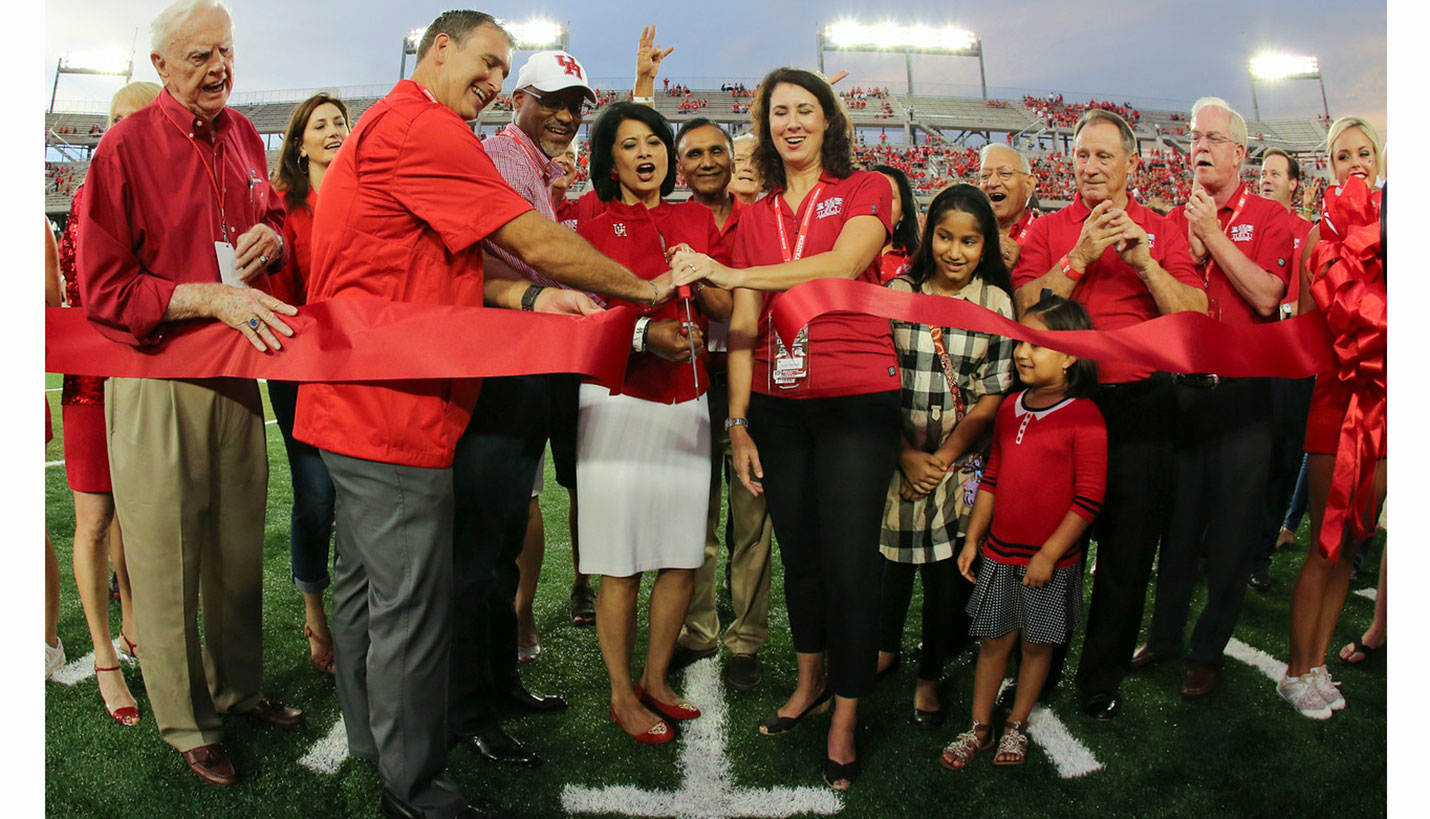
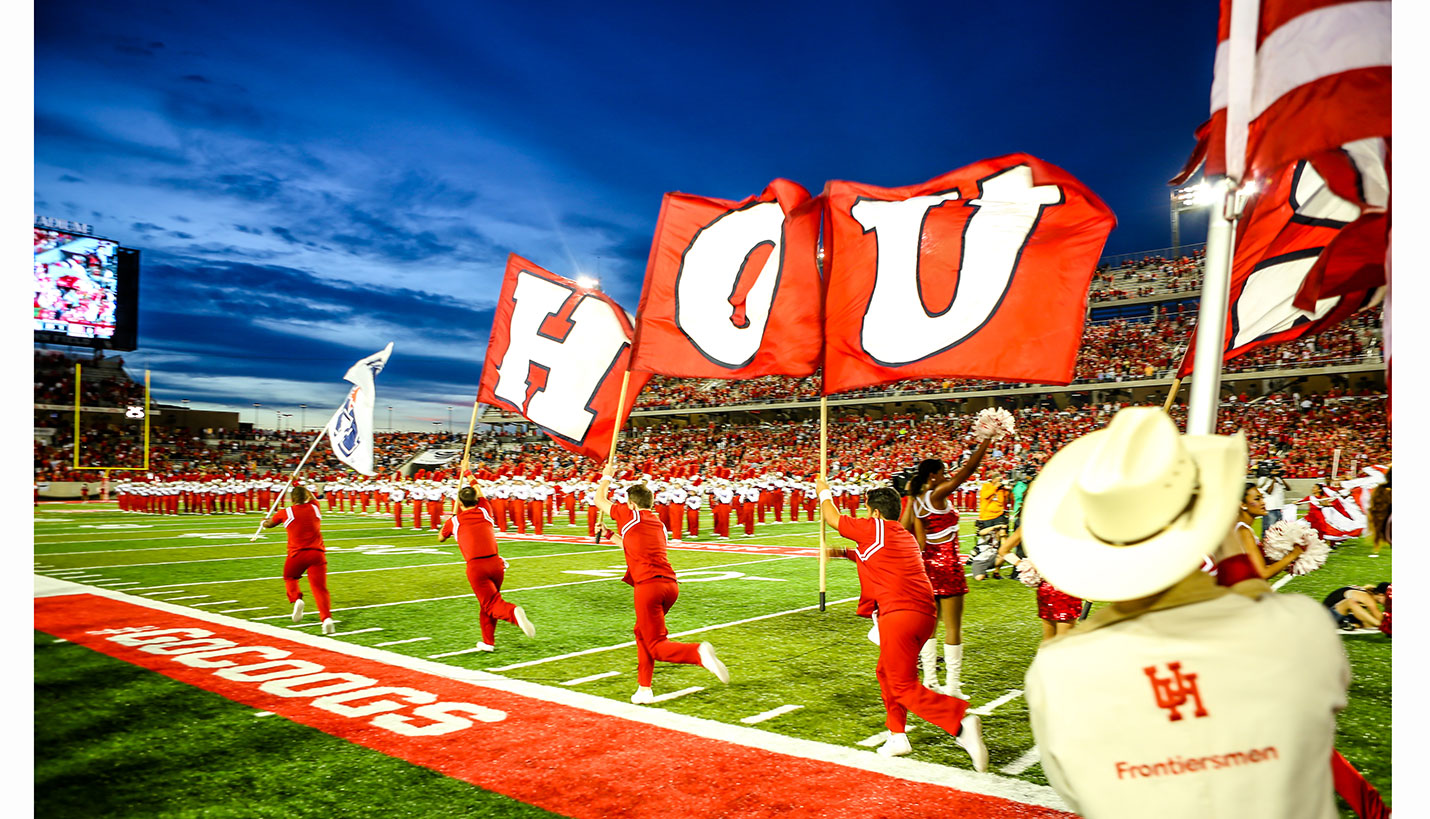
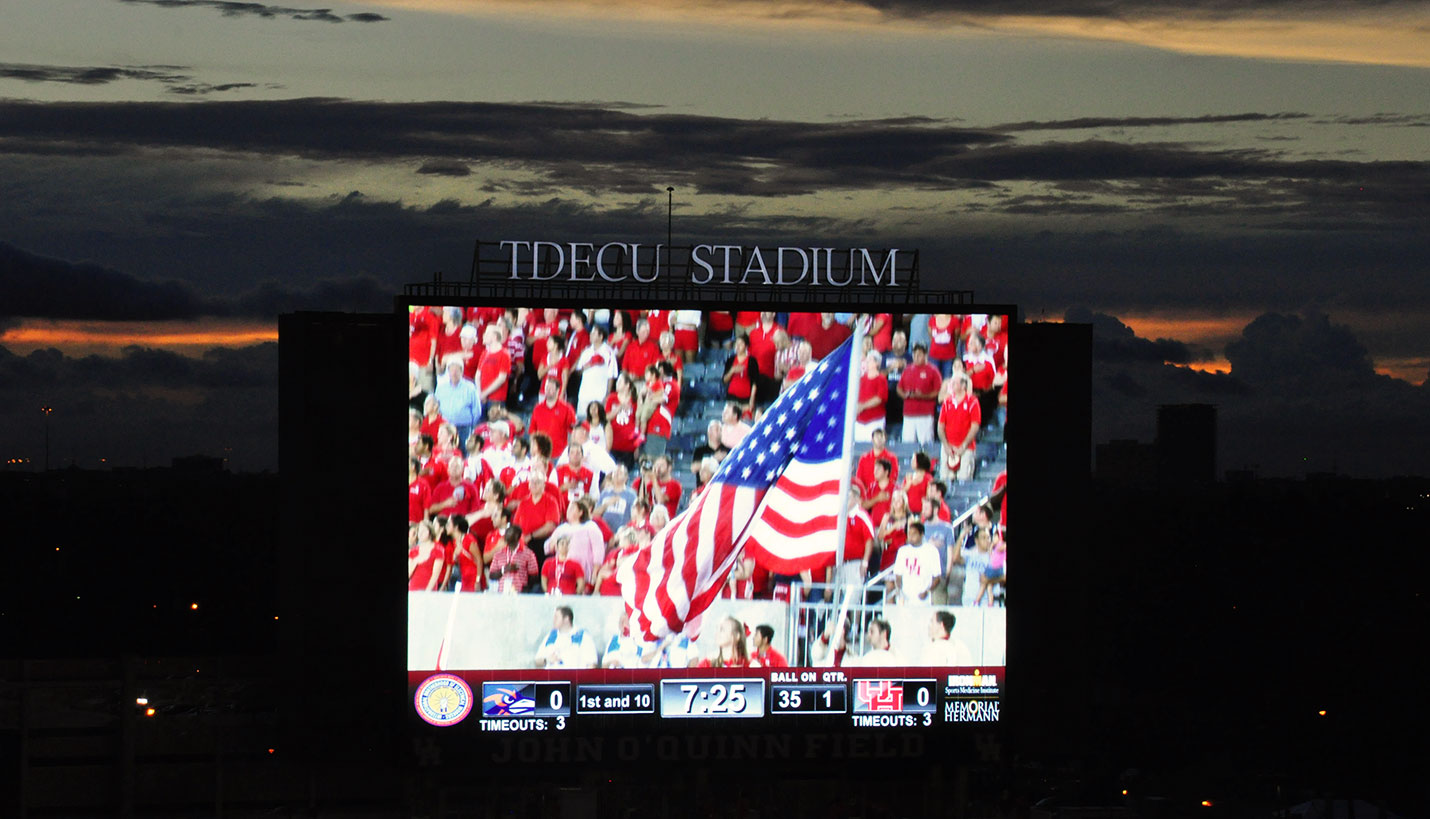
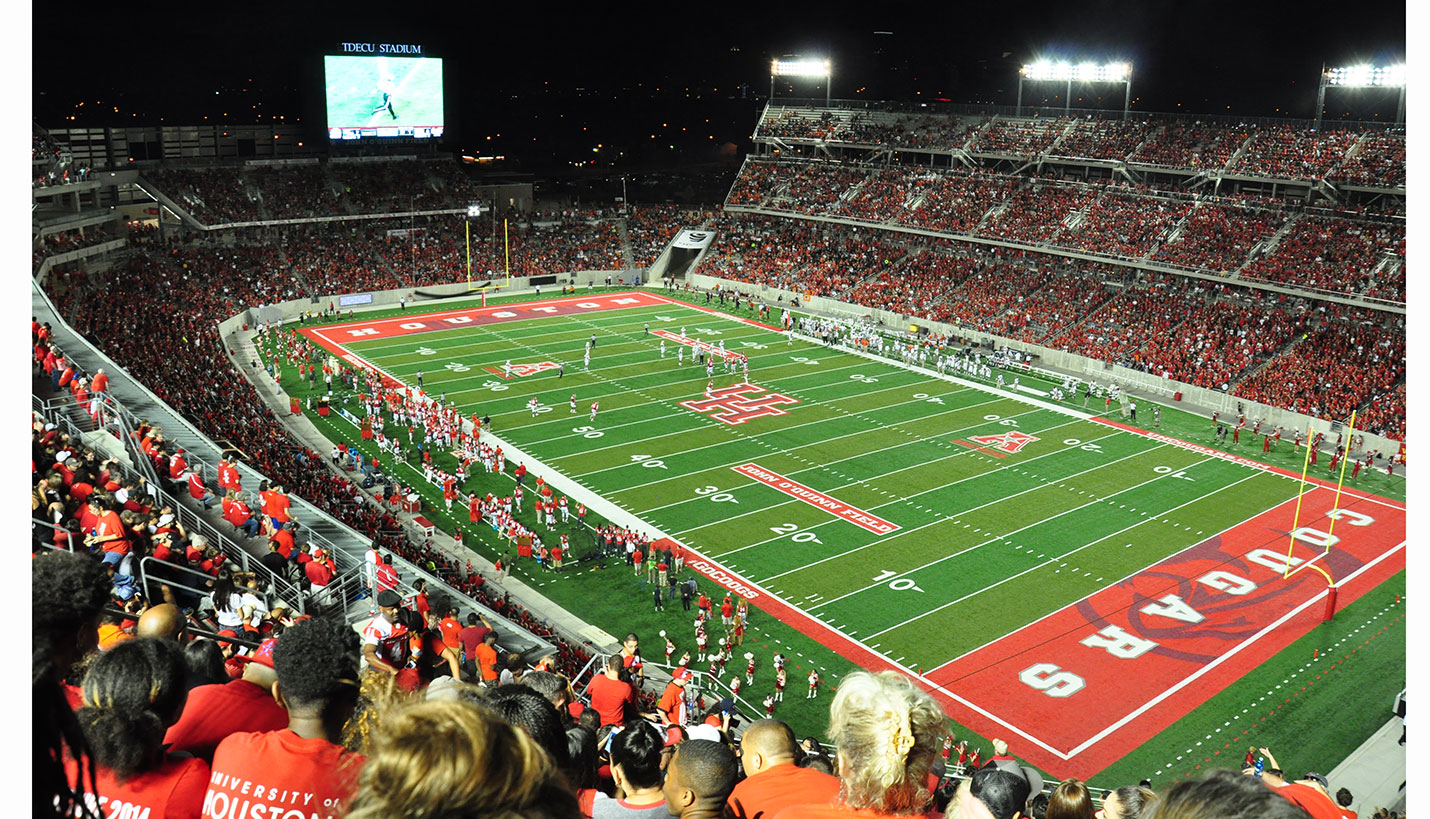
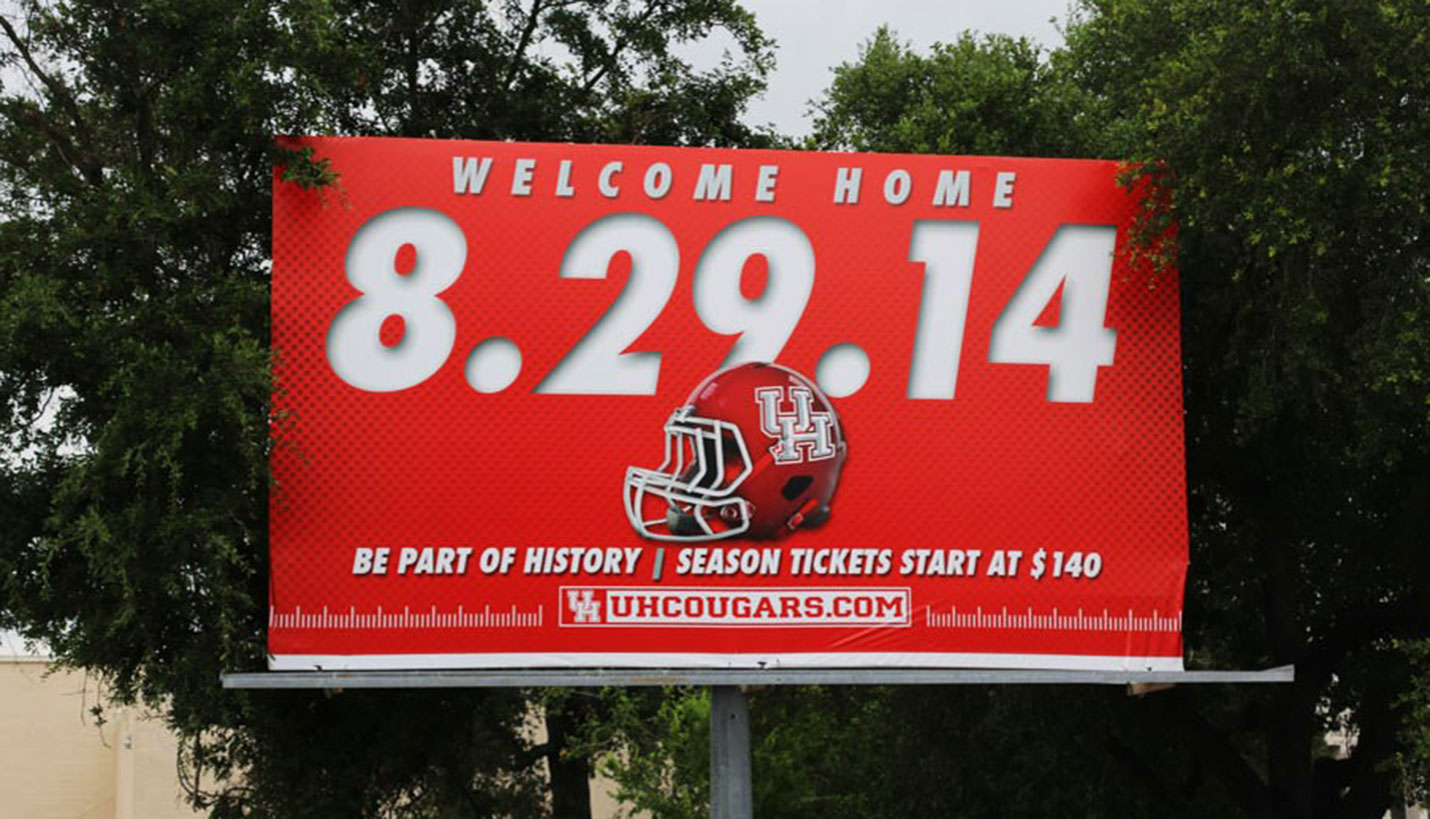

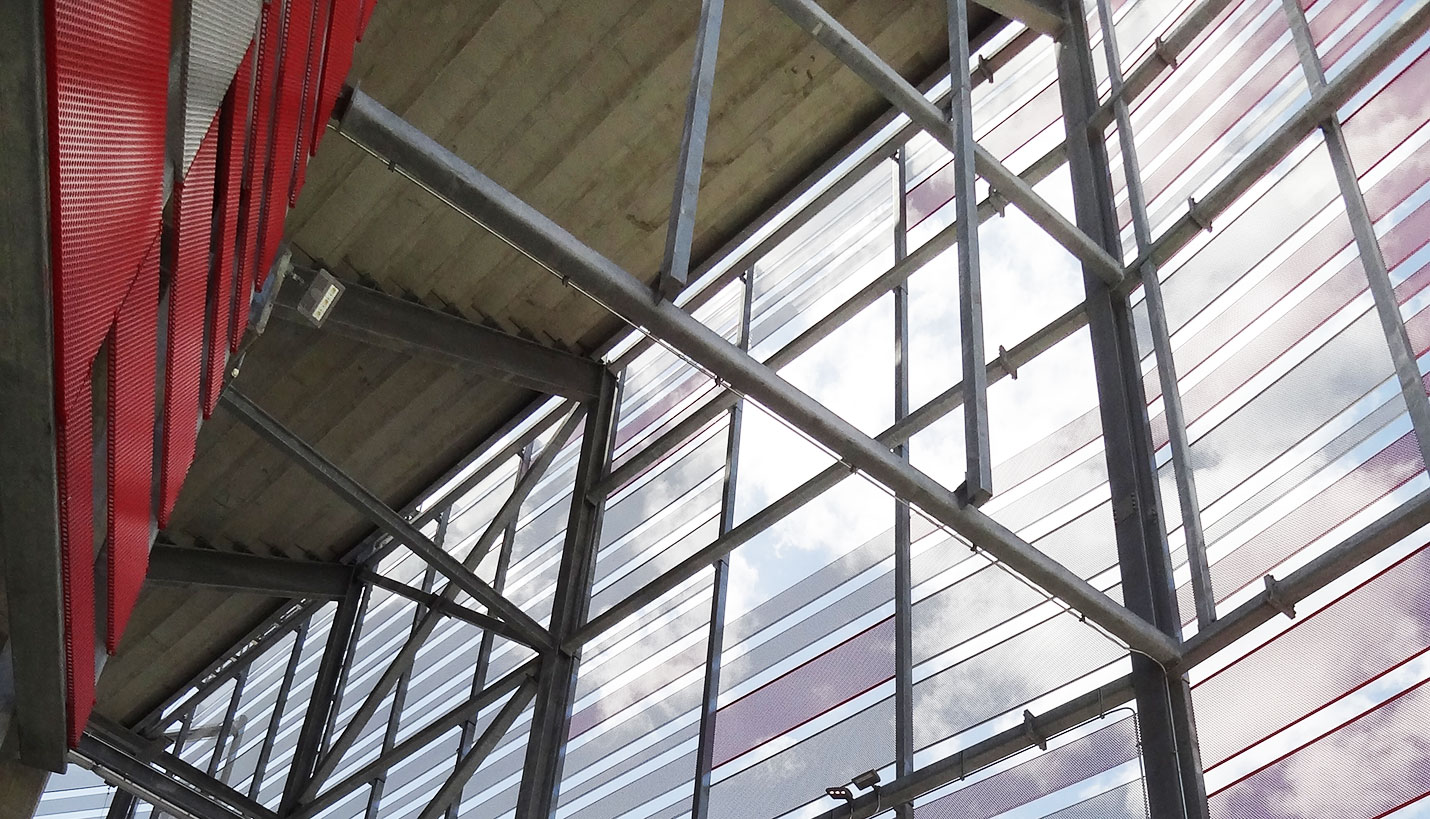
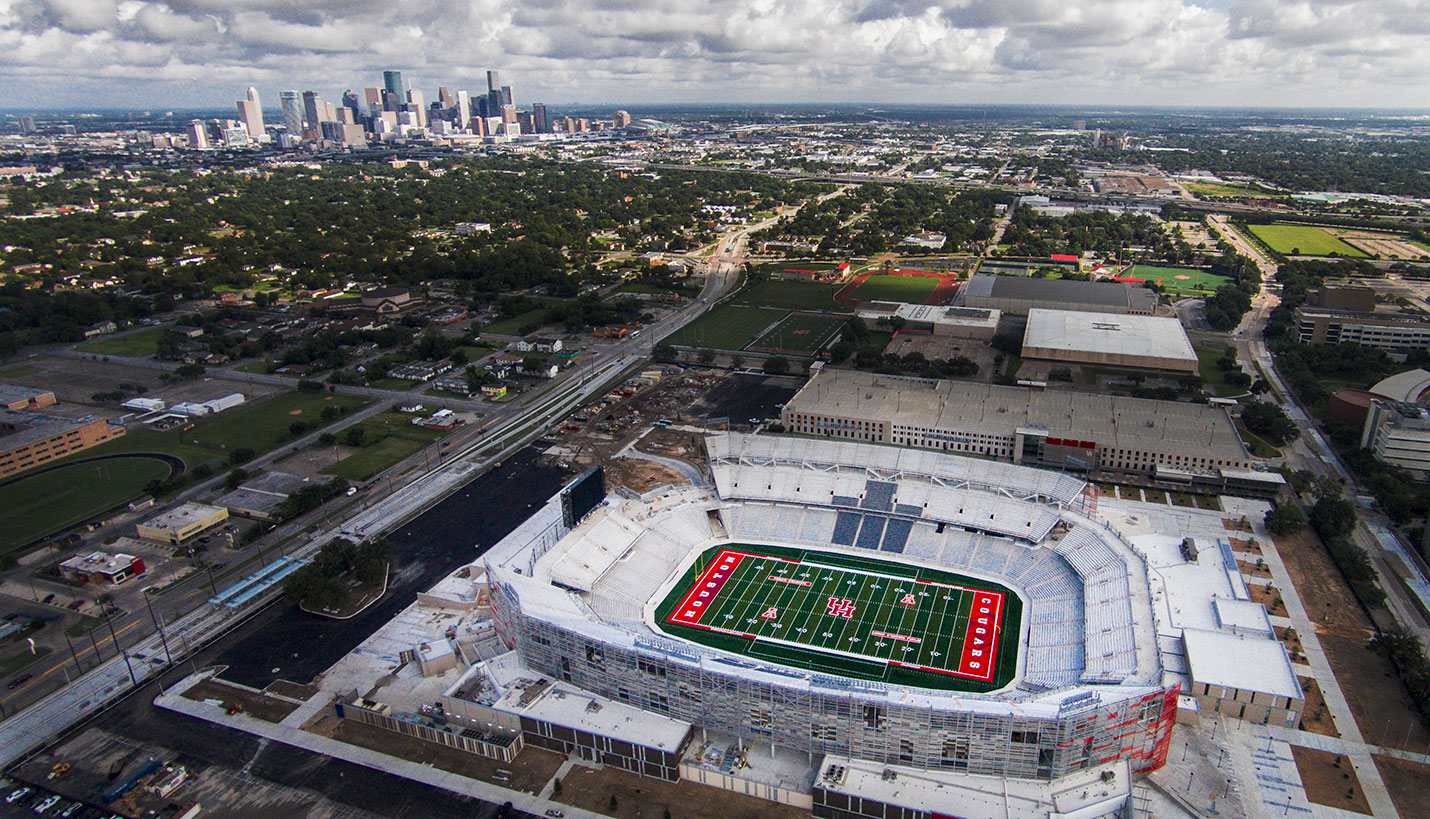

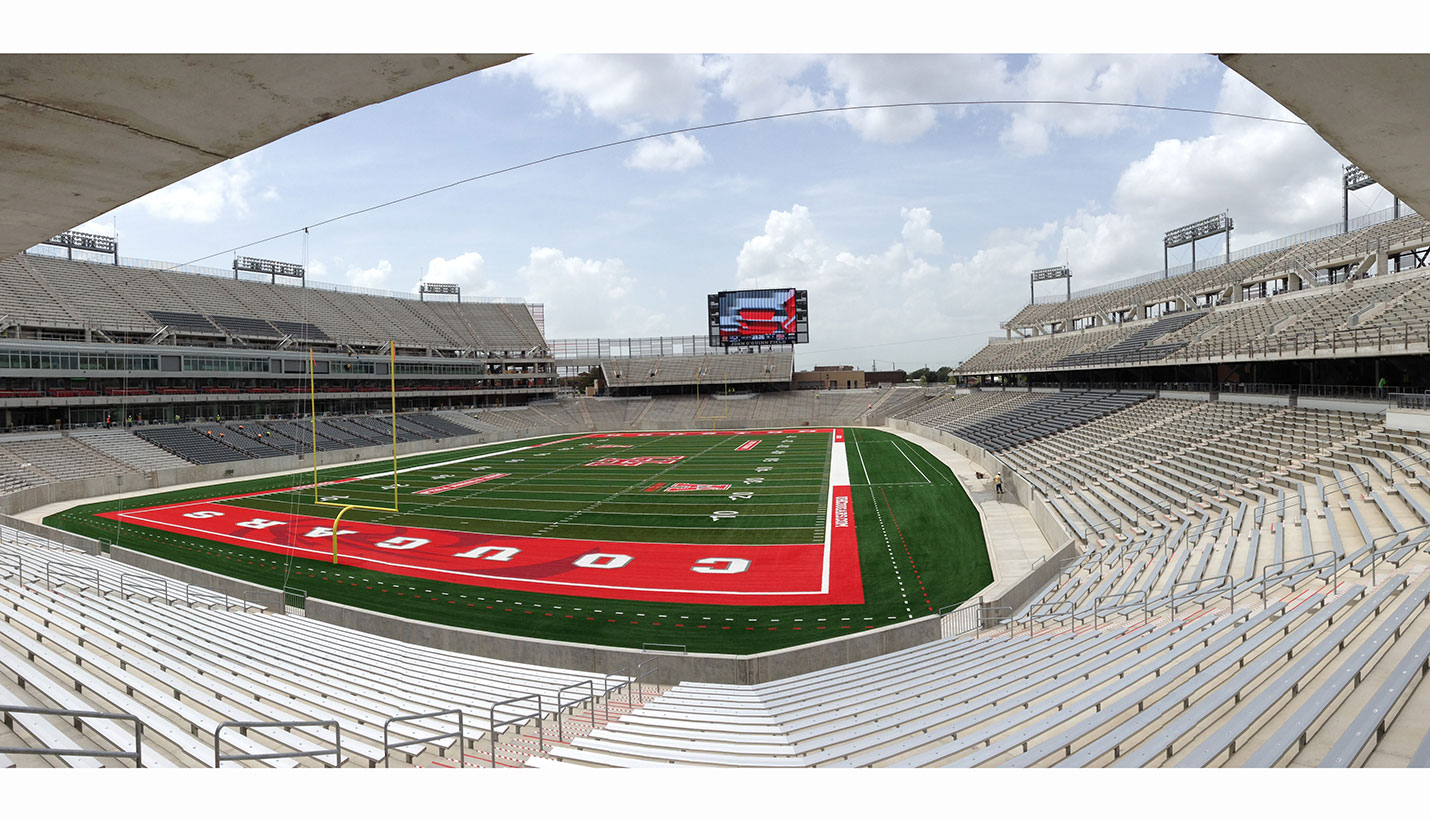

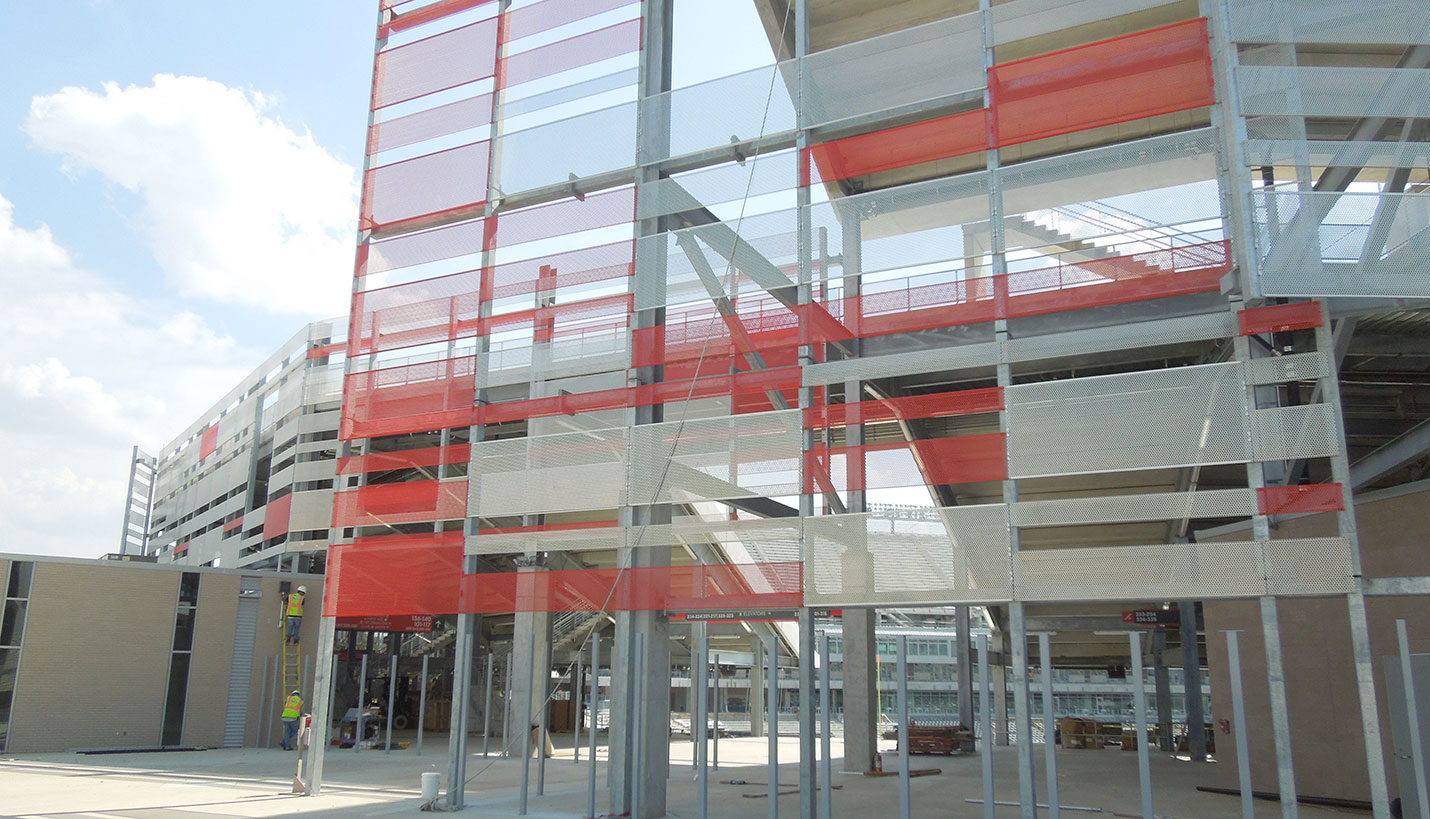
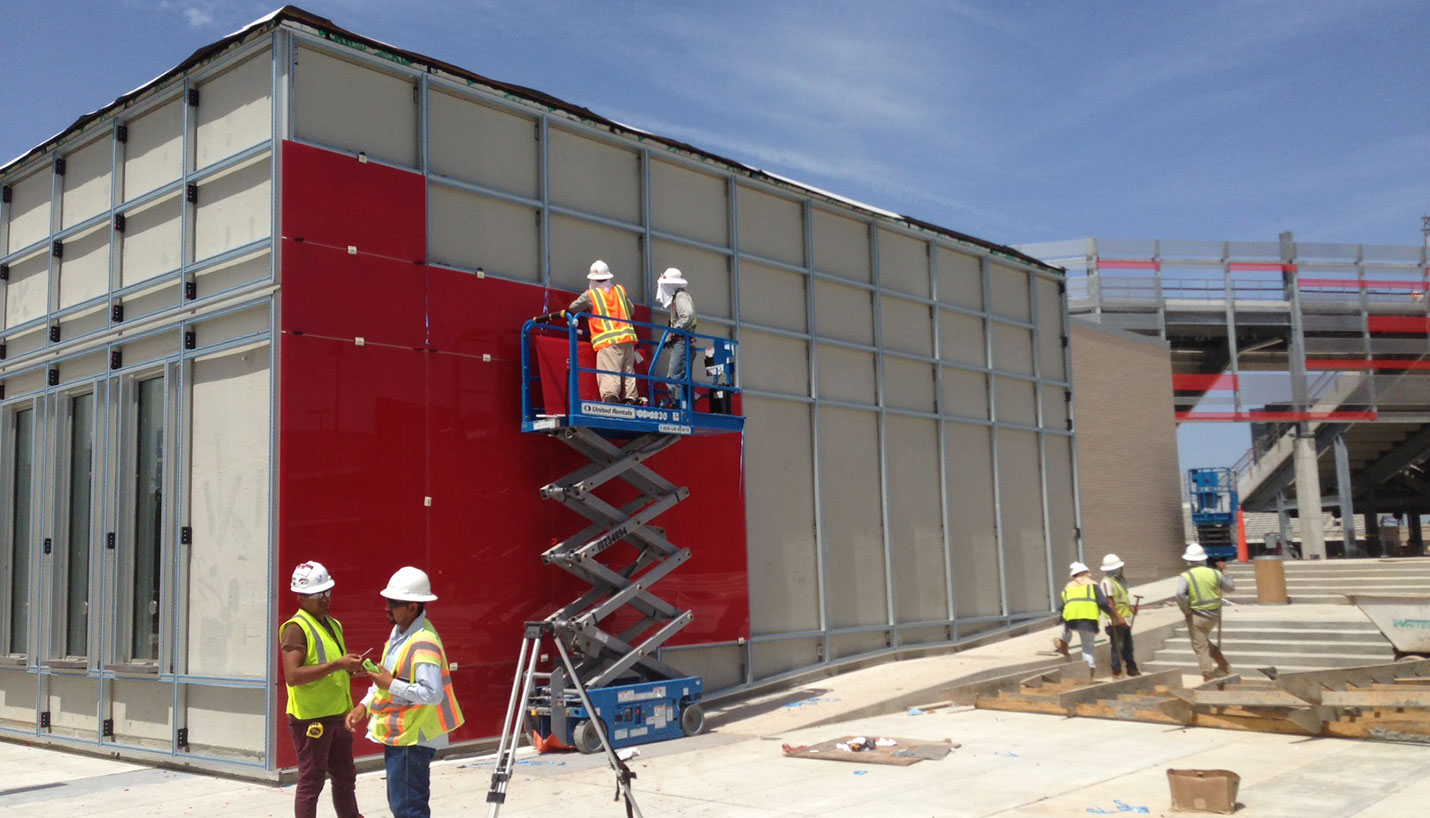
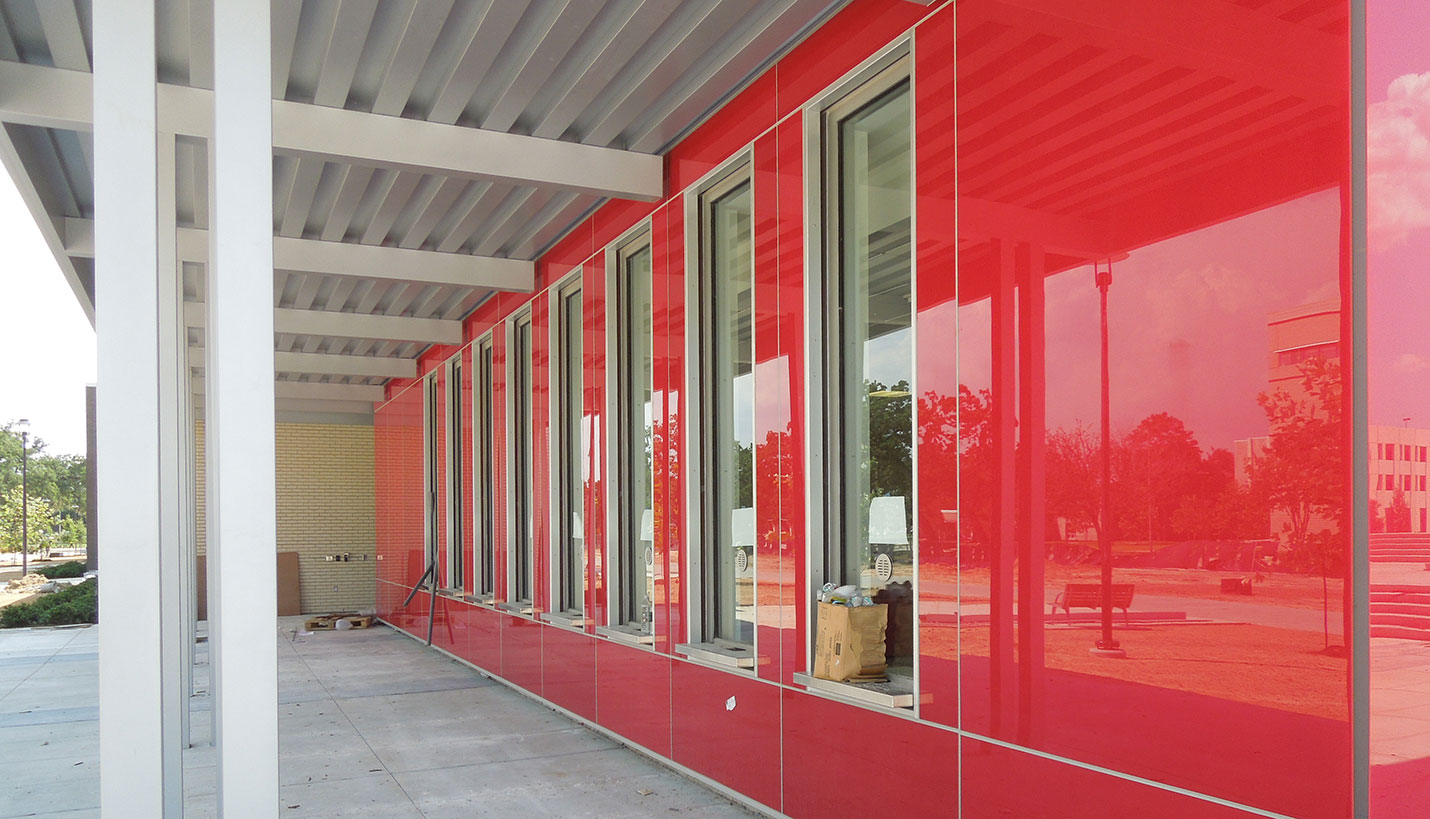

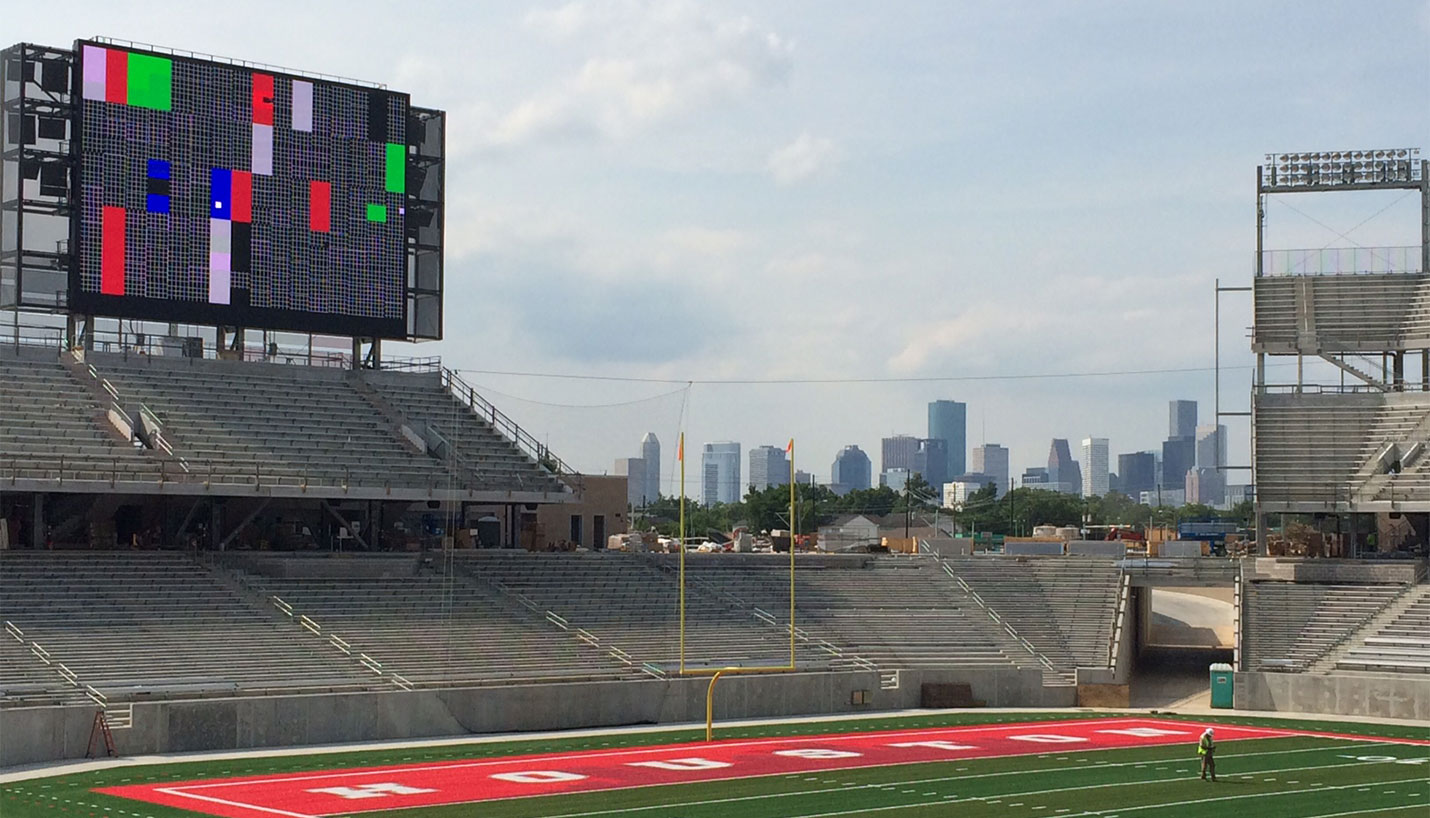
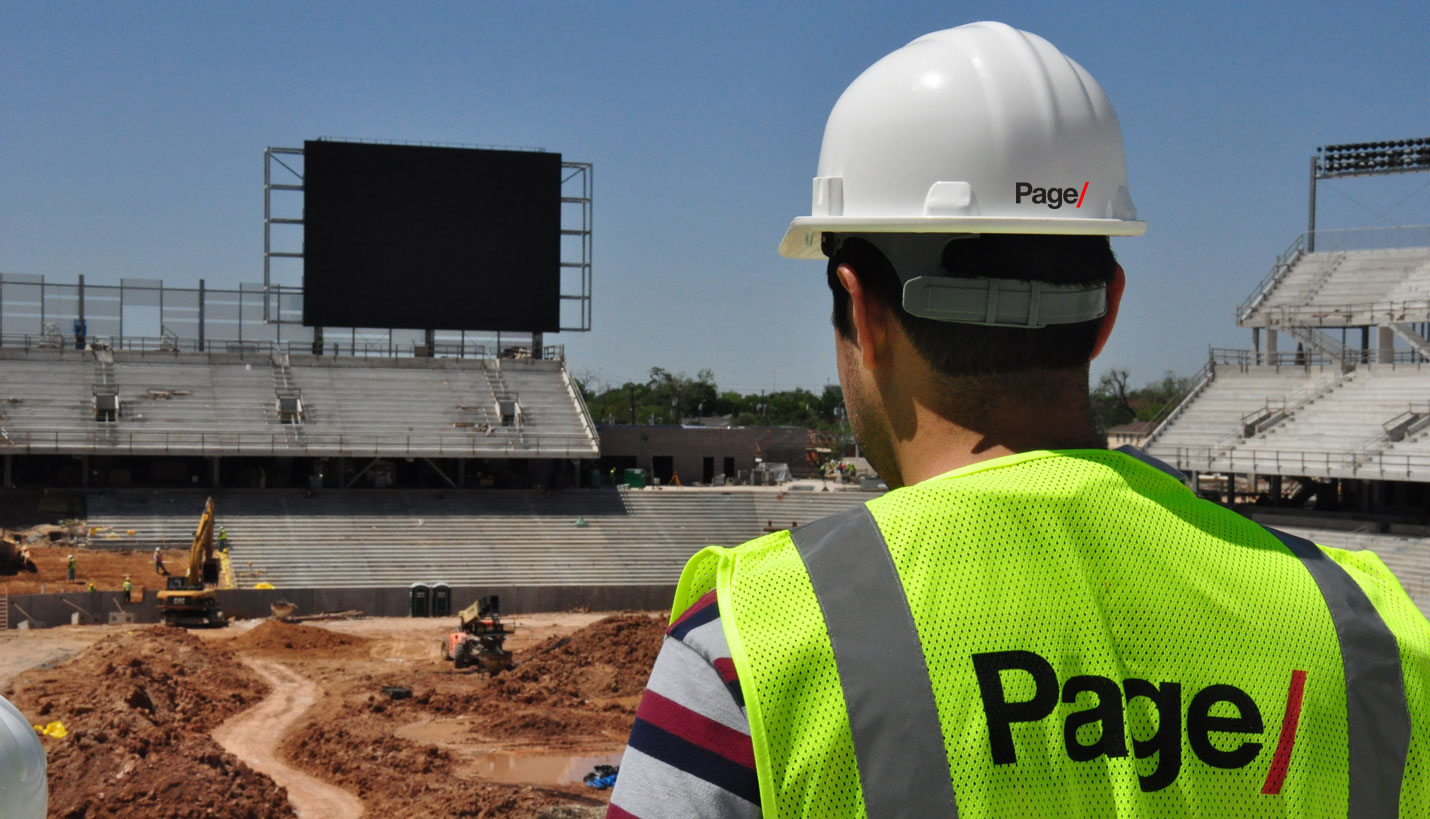
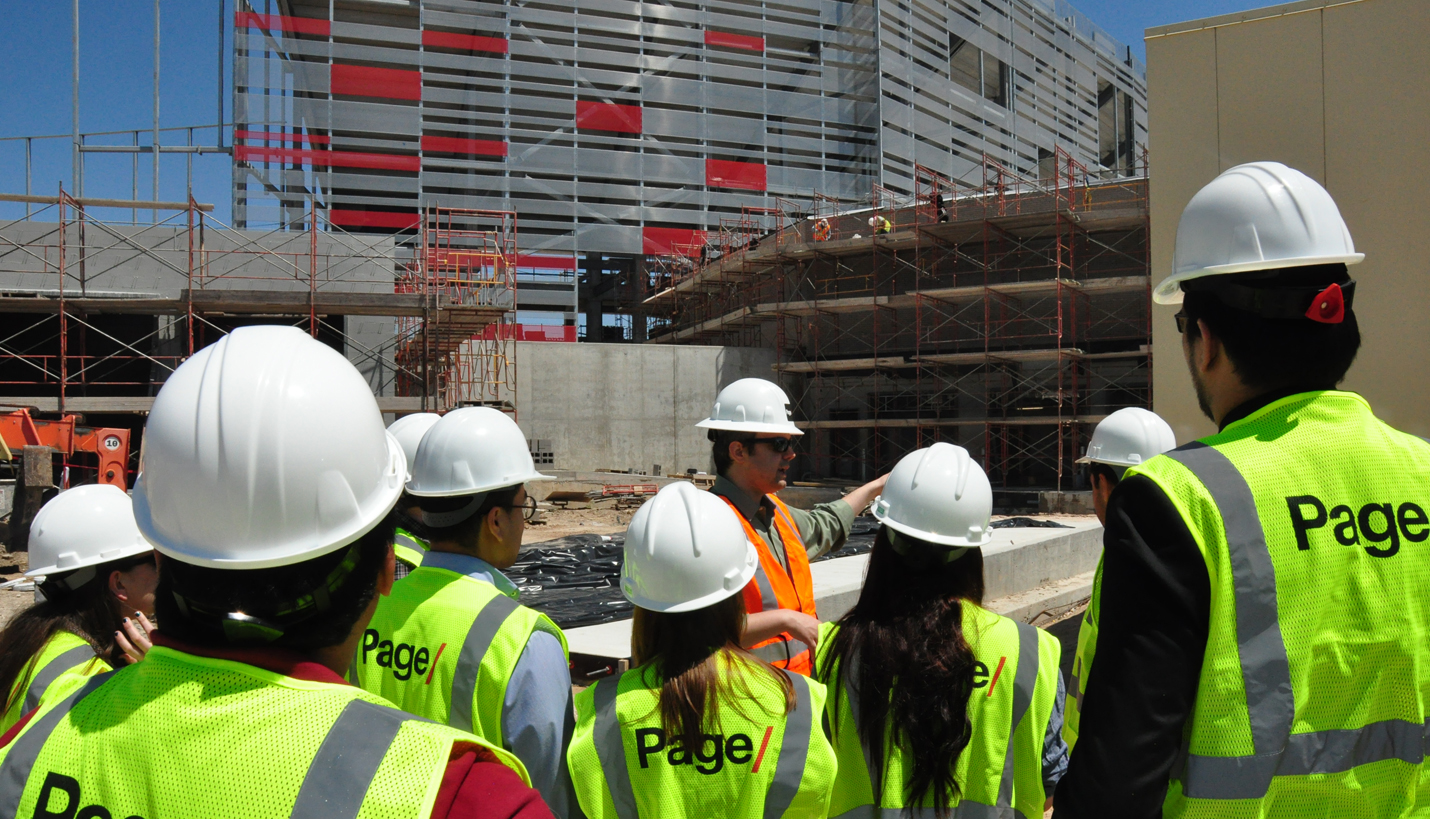
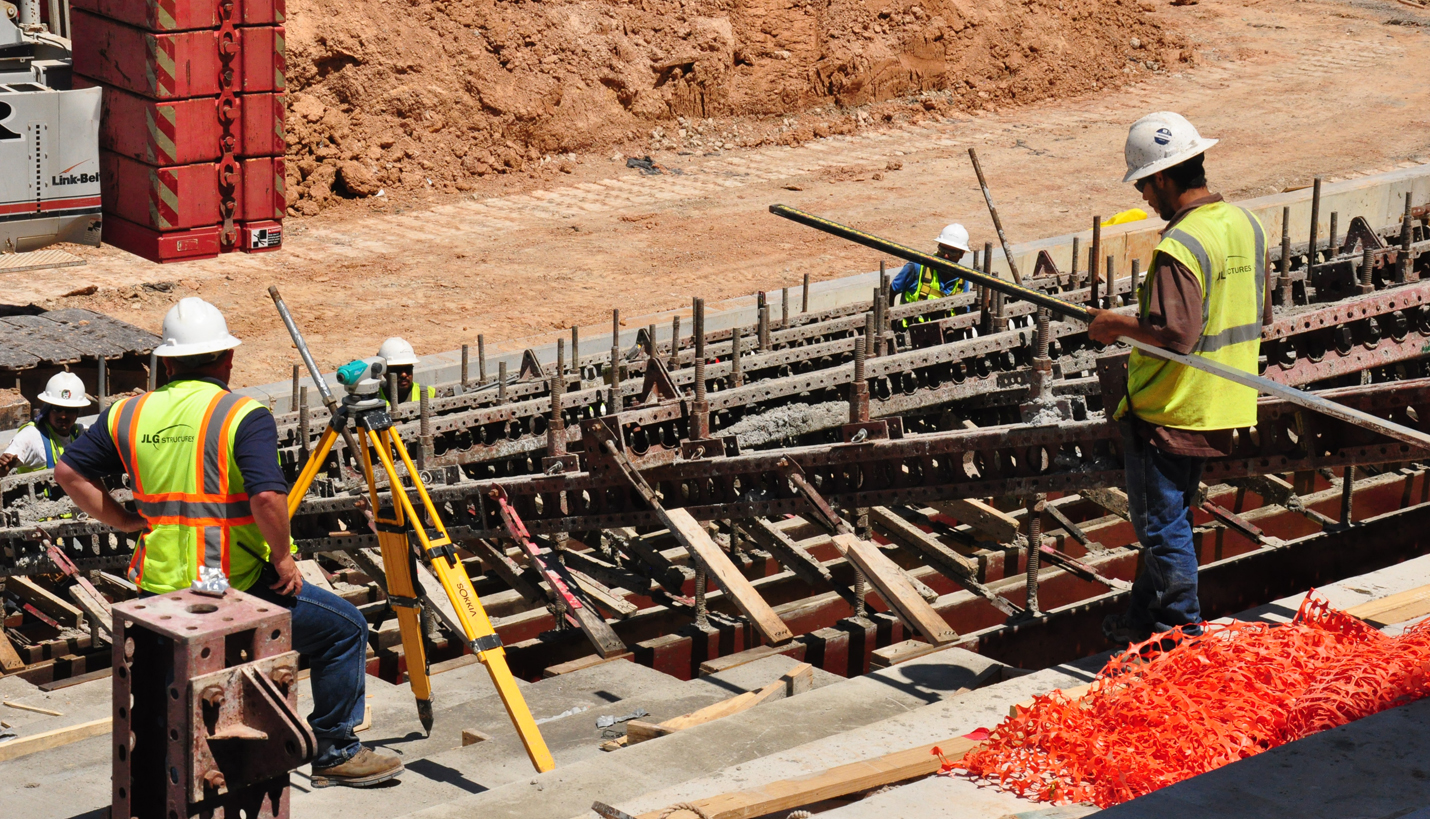
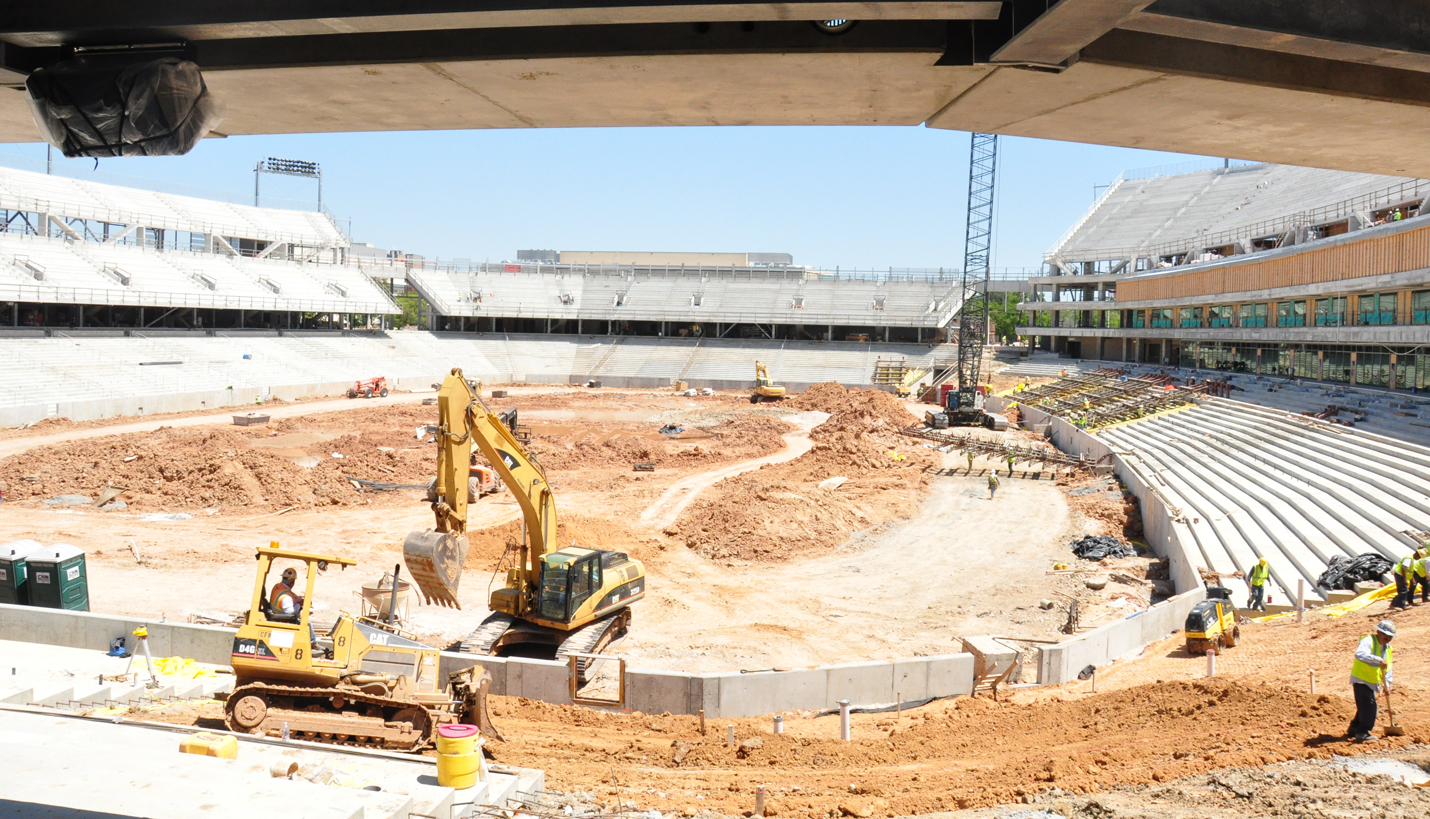

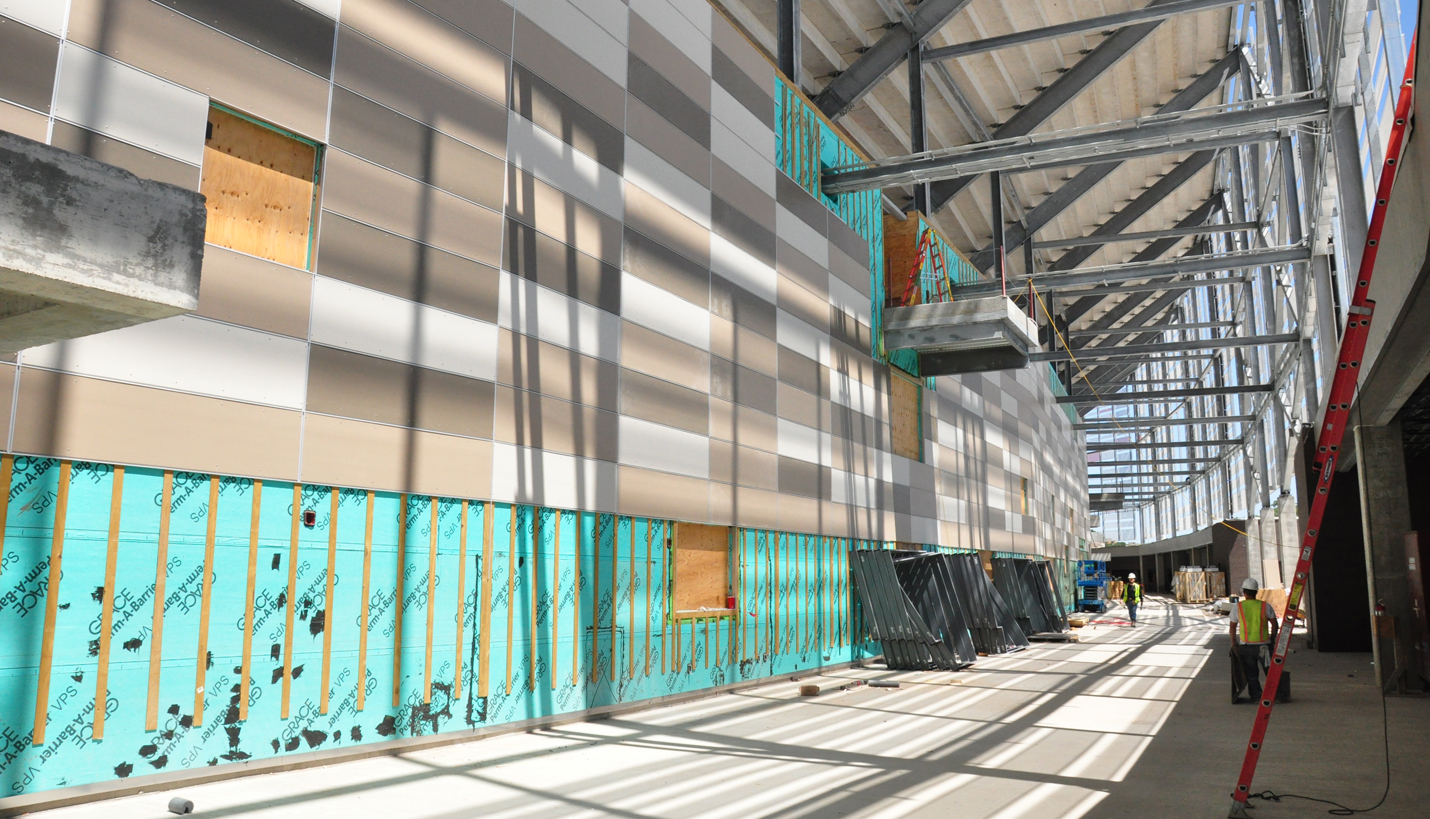
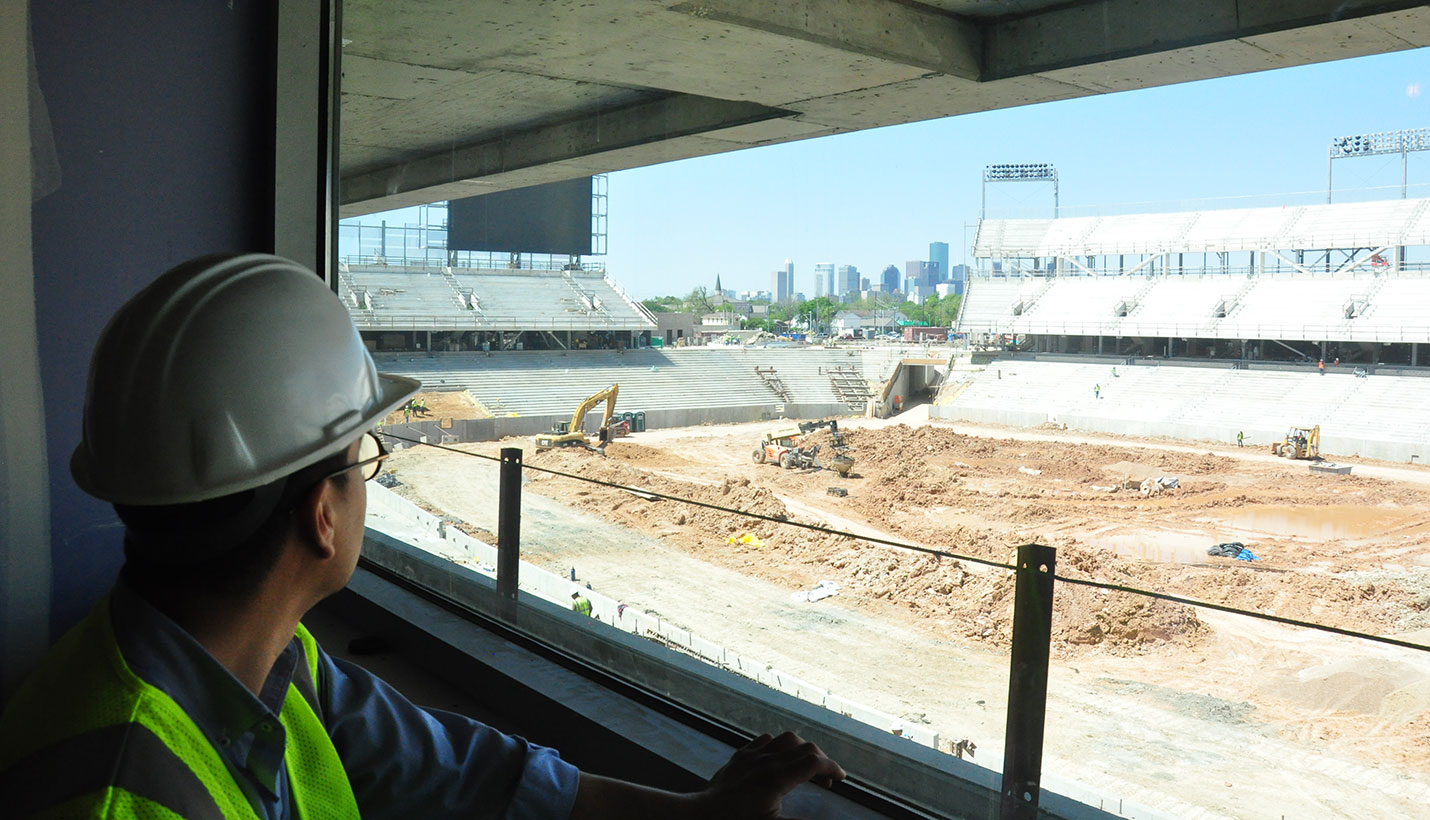

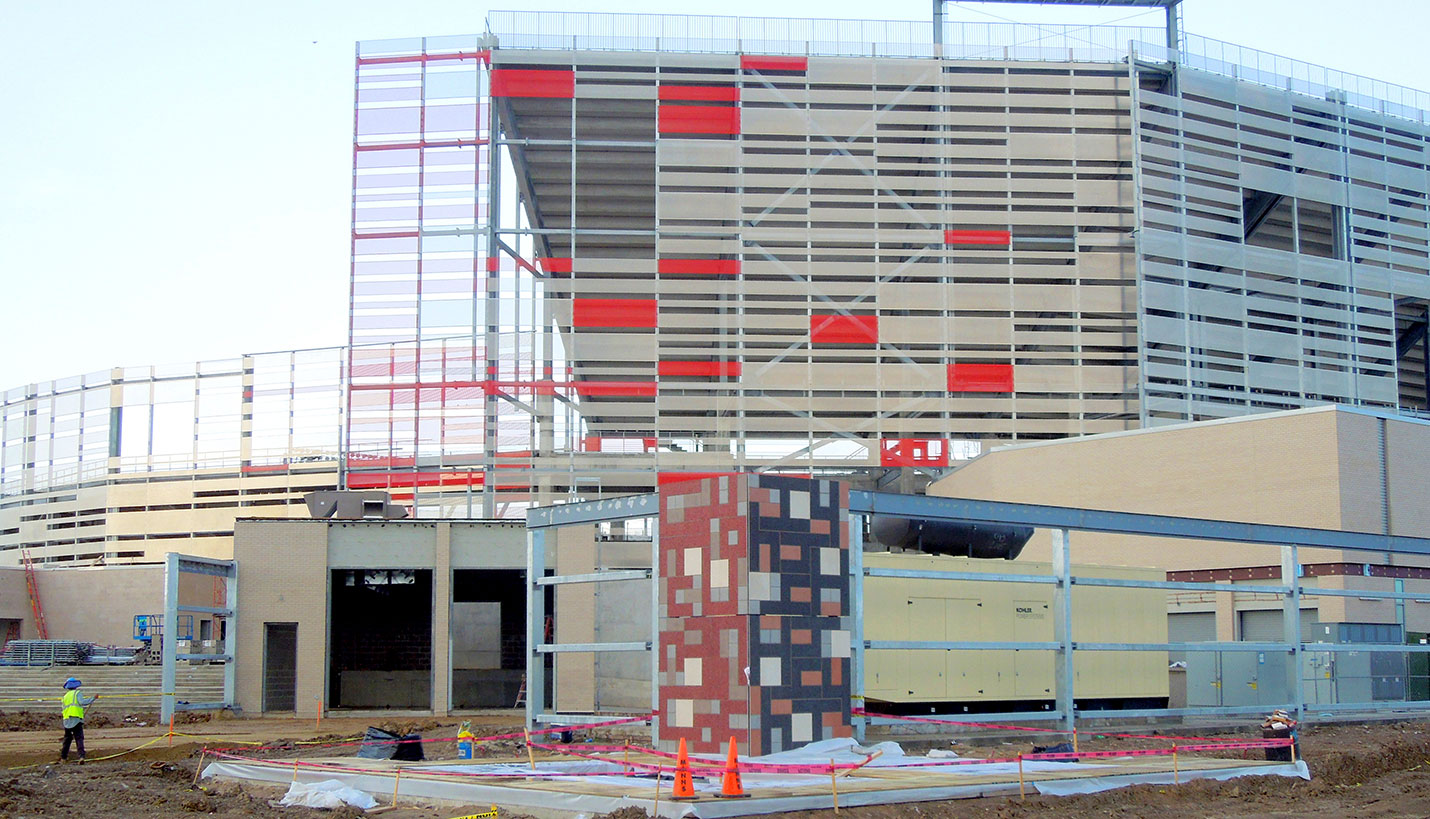
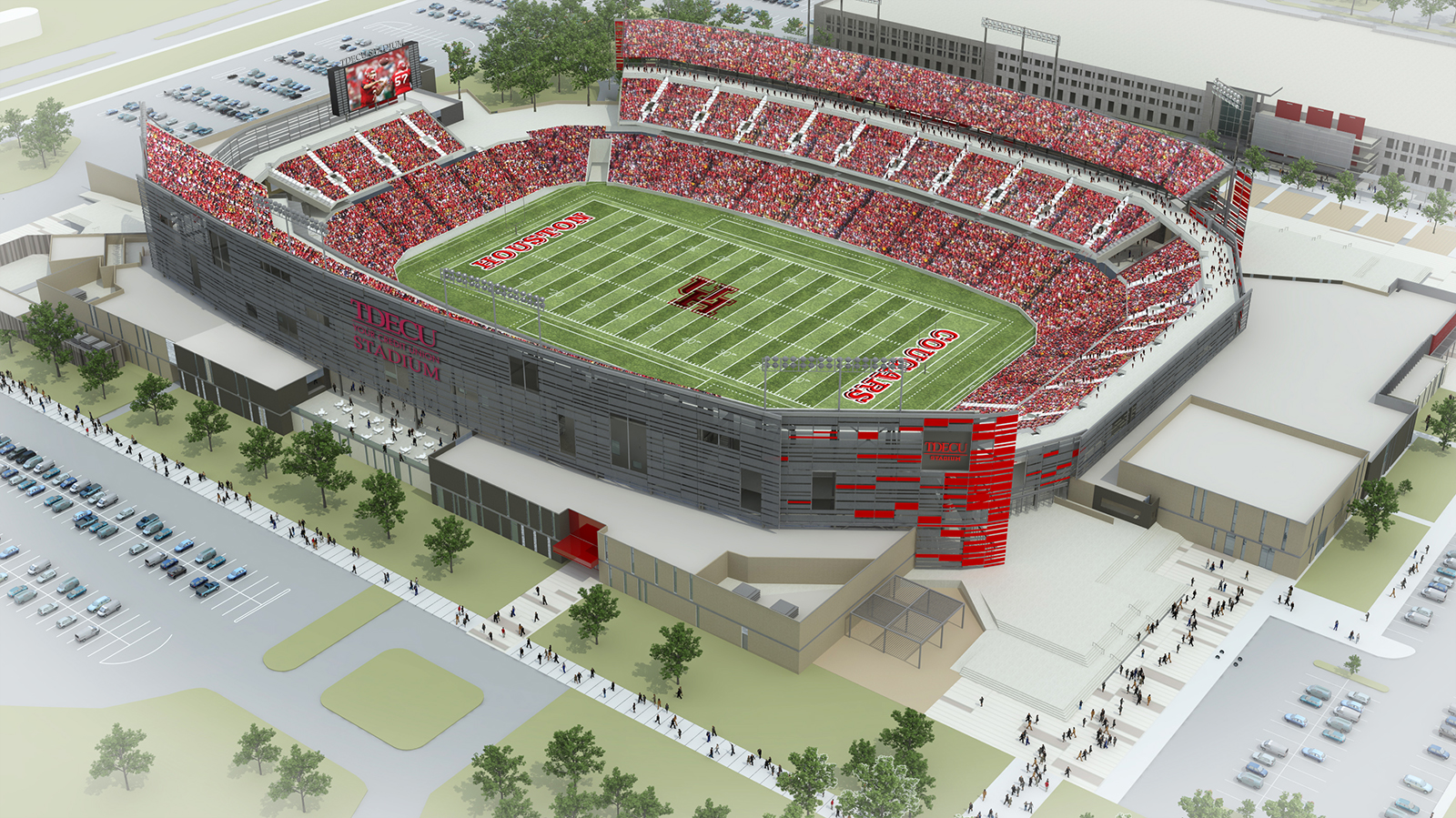

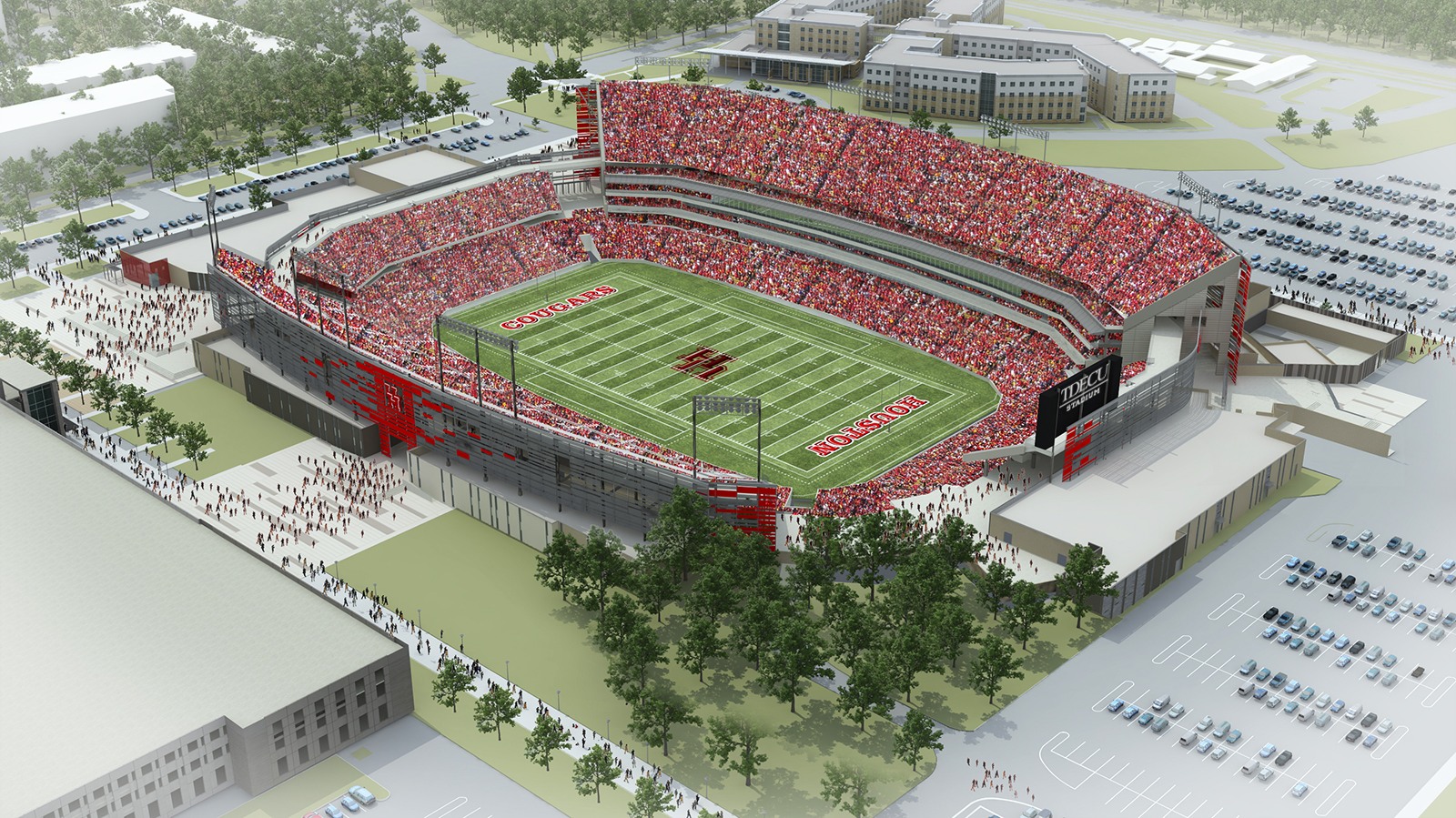
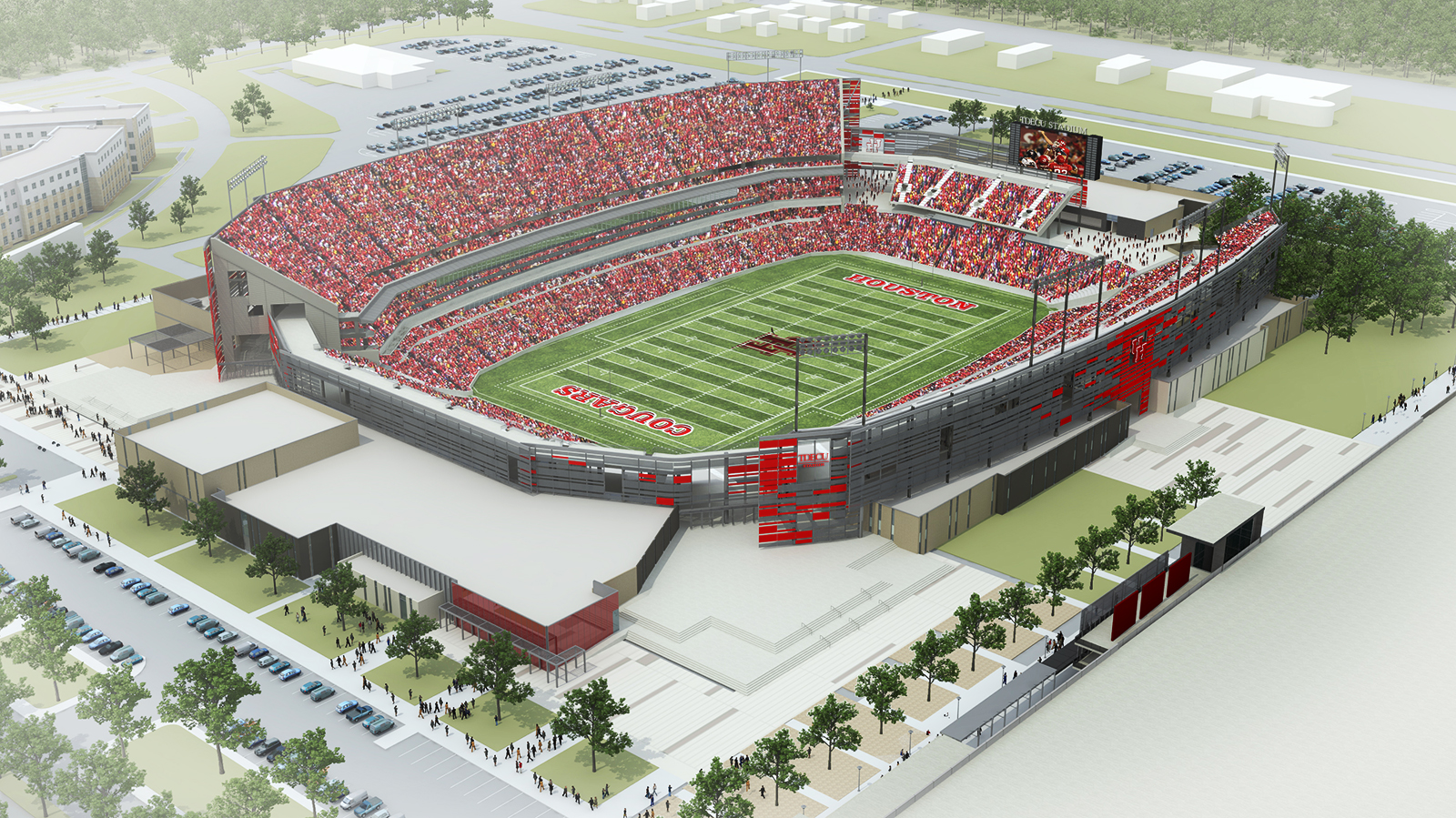
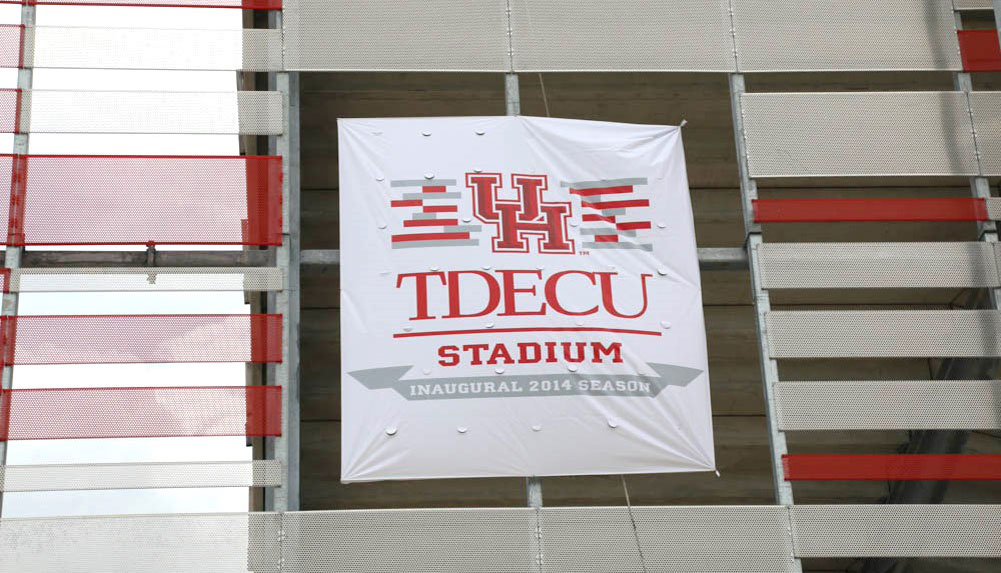
Completion of a Stadium Design
The design and construction of TDECU Stadium at the University of Houston has been a long journey from demolition of the former Robertson Stadium in December of 2012 to the inaugural home game against the UTSA Roadrunners on August 29, 2014. Each of the images in the above gallery as well as the below panoramic from that game shows an element of the stadium design. We'll let them show you for themselves.

GAME ON!
08/29/2014
At 8:00pm CDT today, the snap of a football will signify years of anticipation as the new University of Houston TDECU stadium is officially inaugurated. An entire community of students, alumni and fans have been waiting with anticipation for that moment and Keep Houston Red, a university initiative that encourages people on campus to wear red on Fridays as a symbol of unity, has spread throughout the city.
Page is one of those excited community members, but our pride is greater than most. We’re proud to have been involved in this inaugural stadium built specifically for the university; we’re proud to have been integral in enhancing the way people will experience college football in Houston as well as on the team’s televised games and most of all, we’re proud to have designed an aesthetically distinctive civic facility that will unite members of the community in a common passion.
Today’s weather forecast calls for rain and temperatures of high 80s so be sure to dress accordingly. Come join us in celebrating a new era and honoring the legacy of famous Cougar football players such as Wilson Whitley, Lombardi Award winner in 1976; Andre Ware, Heisman Trophy winner in 1989; David Klingler, Sammy Baugh Trophy winner in 1990 and #6 NFL draft pick in 1992 and Case Keenum, two-time Sammy Baugh Trophy winner in 2009 and 2011. See you at the new TDECU stadium in a few hours!
Looking Good From All Angles
08/27/2014
This Friday, the first University of Houston home football game in TDECU Stadium will mean the beginning of a new era for students, alumni and fans. The Houston Cougars will play their first home game against the UTSA Roadrunners in the first football stadium built specifically for the university. We're very excited to share different views of TDECU Stadium ranging from aerial images to the University of Houston's recent video of excited fans (see Blog Resources below to the right).
The fans' reaction to TDECU Stadium was captured at the recent Community Day which the university hosted several days prior to the opening game. This soft opening allowed facility management to observe activities such as crowd flow and places where people naturally congregated, how fans searched for amenities such as restrooms and concessions, and how staff handled their duties.
Soft openings are common across many industries, from restaurants to retail to public service, to test their new facility operations before officially opening for business. It provides staff with an opportunity to get a sense of working under realistic conditions and allows management to identify opportunities for adjustment before public scrutiny begins.
Page was selected as the design architect of record and DLR as the sports design architect in 2012. Demolition began in December of that year and the first game will be the culmination of thousands of hours Page spent designing the project, coordinating the various disciplines necessary to deliver it from parking to interiors to the playing field and more and generating over 70,000 electronic communications related to the stadium.
Looking good, indeed!
Keeping Houston Red
08/18/2014
When you think of the University of Houston, you think of red. From the UH logo to campus signage to the red-attired students and staff that swarm the campus every Friday, red is an integral part of the University of Houston. This is more than just a tradition; it is who the University of Houston is. Red is their visual identity and unites students, alumni, faculty and supporters in a singular legacy of pride.
Page can relate to this since red is also the firm’s primary color. So while the new TDECU football stadium is clad in materials that reflect the limestone, brick and metal palette of the rest of the campus, it should be no surprise that vibrant red is also an integral part of the design. Throughout the stadium design, red is used to signify key points of interaction with the public. It’s also used as an accent throughout the interior to complete the design.
At each of the four main gates to the stadium, the perforated metal panels of the exterior cage surrounding the seating bowl gradually transition from a muted grey to a striking red that defines the edges of the openings. Back-painted glass is used to create a dynamic red cladding at the main ticket booth and the entry to the club area.
Take a look at the images in the above gallery that show the red elements during various stages of construction this year. Of course, the awareness of red will be further enhanced on Opening Day by fans and supporters that will fill the stadium in a sea of red clothing to support the Cougars in their first home game against the UTSA Roadrunners on August 29. We’ll see you there!
The Architect's Role: Stadium Design
08/07/2014
Architects do far more on most projects than the design. The new University of Houston TDECU football stadium, which will host its inaugural game on August 29 against the UTSA Roadrunners, is no exception. While Page is the design architect of record and DLR Group is the sports design architect, Page is charged with oversight for each element of the stadium. This ranges from overseeing the commissioning of the public artwork to ensuring building code compliance requirements to constant client communication to making certain all new parking spaces are striped an appropriate distance from each other, and more.
In this phase of stadium construction, Page is working with WJHW (Wrightson, Johnson, Haddon & Williams, Inc.), a specialty designer and planner for commercial audiovisuals to confirm the video board, sound system and TV systems function as intended. Take a look of the scoreboard in the above photo – the selection of the testing color blocks is deliberate so that fans can experience the actual graphics for the first time in person on Opening Day, August 29.
Beneath The Walls: A Tour of The TDECU Stadium Design
07/25/2014
A behind-the-scenes tour of TDECU Stadium last spring gave graduate architectural students the opportunity to see the building systems, assemblies and activities, particularly those that will not be apparent once construction is completed. For example, Justin Winchester, Page senior project architect, called the students’ attention to the concrete pour underway for the bleacher seat platform, which was formed using an intricate rigging system, pictured in the above gallery. The rigging system will no longer be evident when the stadium is ready for use.
The tour included the concourse areas and concessions stands. Some of those openings are 25’ wide with no intermediate supports, as pictured in the above gallery, which was achieved with steel I-beams. The students also walked through the new 12,400-square foot club level and lounge overlooking the field and the 26 suites stretching from end zone to end zone on the stadium’s south side. This gave them the opportunity to discuss various viewing positions throughout the stadium.
In addition, the class visited the state-of-the-art locker facilities, including the UH home team locker room, and discussed key design elements such as access to the field as well as the parking lot, layout and plumbing. The students were also some of the first outsiders to see the framework for the “Cougar Cage”, a permeable, patterned metal enclosure which will provide a unique identity for the stadium. At the corners of the cage, red glass elements are gradually introduced to mark the entry locations. Take a look at the above images because the stadium is much nearer completion today and already looks very different.
The Texas Tech University College of Architecture program is located in Houston so its students in the Graduate Topical Studio in Urban Design course have the opportunity to visit construction sites in the area with their professor, Page Principal John Clegg.
The Art of a Football Stadium Design
07/18/2014
It may surprise fans awaiting completion of the new UH TDECU football stadium to know that public artwork was part of the design. While some may think the stadium's primary function is to provide a designated space for fans to watch players, it actually will serve a larger purpose as a civic structure. These are prominent public spaces that unify visitors and the communities in which they're located by capturing the spirit of the place. The new UH TDECU stadium will help convey that spirit through the outdoor public artwork by artist Jim Isermann.
The installation is prominently located at the southwest corner of the stadium and also anchors the new pedestrian link being created between the new Metro Southeast (Purple) light rail station and campus. The piece consists of 19 precast panels, mounted horizontally and vertically, of recycled crushed red glass and black onyx intended to evoke the school colors. Each panel stands 8'x8' and weighs about 1,500 lbs.
Page worked to integrate the installation into the design of the stadium by collaborating with the artist, the artwork project manager Metalab, the manufacturer of the panels Gate Precast, and Michael Guidry, Curator of the University Art Collection at the University of Houston. Installation successfully took place in early July despite rain delays. For more details on the process, visit the Metalab blogpost here.
Look closely, can you find the U's and H's in the above images?
New Name, New Game
07/09/2014
University of Houston Cougar fans near and far held their breaths yesterday in anticipation of the announcement of the new name of the football stadium currently under construction. According to local Houston media, the naming rights partnership with Texas Dow Employees Credit Union (TDECU) is remarkable for its lucrative terms. However, a University of Houston alumnus got to the heart of the matter in his brief tweet:
This stadium is huge folks. Our school will be on the map.
While many alumni appreciate the education and development their alma mater provided them, The Alumni Factor notes that college athletic programs can create a strong emotional bond that survives graduation. Supporting one’s college team can be a powerful shared experience with family and friends, as well as between generations. In particular, high-profile and successful sports teams can generate a sense of belonging to a community among their fans.
Page, the design architect of record, and DLR Group, the sports design architect, have worked very hard to make the successor to Robertson Stadium a transformative game day experience for fans and student-athletes alike. Page’s vision is to design places that have a significant impact on the communities they serve and if stadium visitors feel their total experience was positive visually, physically and emotionally, then we will have succeeded in our objective.
09/05/2014
People
- Ashley I. August
- Jeffrey Bricker
- Arturo Chavez
- John N. Cryer III
- Ernesto Galvan, Jr.
- Ron Gilbert
- John F. Gloetzner
- Angela Gonzalez
- Alberto Govela
- Dawn House
- Elaine Lee
- Abbey McCann
- Cristina Morales
- John Garrett Neubauer
- Andy Phan
- David Quenemoen
- Lawrence W. Speck
- Chelsea Walker
- David Weatherly
- Justin Winchester
Blog Resources
Related Posts
- Topping Out of New Pediatric Orthopedic Institute
- Houston Basketball Dedicates Guy V. Lewis Development Facility
- Transformational University Designs Win Awards
- University of Houston to build another multimillion-dollar sports facility
- Designing University of Houston Athletics for the Next Century
- UH to begin constructing $25 million basketball practice facility
- Yes, Page Designed That Too!








